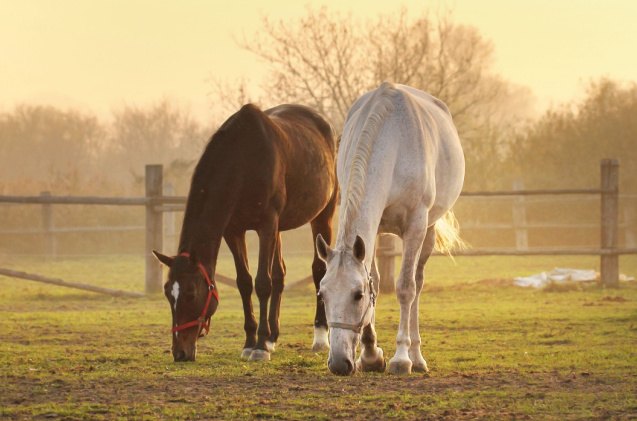5 Internal Parasites That Affect Horses and How to Prevent Them

All horse owners know that it is crucial to deworm horses, as internal parasites can be a big threat to their well-being. Also known as the “silent killers”, internal parasites need to be kept under control in order to avoid extensive damage to a horse's health and immune system. Let’s go over the basics of the most common internal parasites and how best to deal with them to keep your horse safe and healthy.
What Are Common Internal Parasites in Horses?
As most know, a parasite is an organism that lives within and feeds on its host. They have a life outside of the horse, and inside it also. A common way that a parasite enters your horse’s system is through pastures and grazing: a horse can accidentally ingest the parasitic larvae, which then begins a new lifecycle within the animal host’s organism. There are more than 150 parasites that can affect horses, some rarely and others more often. Needless to say, a heavy load of parasites in your horse can have drastic effects on their health and have to be treated. Your horse can experience weight loss, colic, diarrhea, potbelly, coarse coat, and many other ill effects. Common signs of parasitic infestation also include lethargy, mouth lesions, hair loss, coughing, nasal discharge, sores, and loss of appetite. This is why it is key to have regular vet visits and to deal with parasites quickly and efficiently. But, before we go over treatment and prevention options, it’s important to know what sort of parasites infect horses in the first place – and what symptoms they cause.
Tapeworms
Perhaps the most common internal parasites, tapeworms are generally classed into three species that affect equines. They are found on a species of mites that live in grass. Horses ingest them while grazing, and with them the tapeworm larvae. The parasite then lives on in the horse, after being released in the small intestine. The tapeworms will attach to the gut and cause inflammation of the intestinal tract. This causes colic, ulceration, obstruction, and thickening of intestines, amongst other hazards.
Pinworms
Also common are the so-called pinworms, also present in our environment and consumed by the horse in their egg form. Ingested, they grow and mature within the horse's intestinal tract. However, once they reach adulthood, they exit the tract through the anus and lay eggs there. This causes discomfort for the horse, who will feel an intense itch and constantly rub its tail and its backside. Pinworms are the least dangerous, as they do not generally affect the intestines, but rather the outside areas. Excess scratching, however, will cause hair loss in the tail and its area, and also possible scratches. Nevertheless, they are internal parasites and require your care.
Large Strongyles
Strongyles, both large and small, also affect horses. Strongyle larvae are found on pastures, cunningly hidden within dew droplets on blades of grass. Once ingested by the horse, they can cause havoc on their system. Traveling through the intestines, they will enter the blood vessels, burrowing in the walls of arteries and thus disrupting blood flow. This earns them their popular nickname – “bloodworms”. Other types of strongyles will attack the liver and then migrate to the intestines, but will not affect blood flow. Either way, they are amongst the most pathogenic and damaging internal parasites, but are generally rare nowadays, thanks to special treatment strategies that have reduced their presence in pastures.
Bots
Bots are parasites coming from the bot fly and can live both outside and inside a horse. Bot flies will land on a horse and lay their eggs in its coat, often on the neck, mane, or lower front legs. The horse feels the eggs, which cause him discomfort, and he will try to bite or lick them off, thus ingesting them. The larvae hatch and burrow in the horse's mouth, in the gums. They then pass into the internal system, burrowing into the lining of the stomach and remaining there for nine months. They cause oral lesions and damage to the stomach lining, amongst other issues, but are not as harmful as other internal parasites.
Threadworms
These internal parasites are commonly seen in foals and older horses. The larvae of the threadworms are ingested either through grazing and the environment, through the mother’s milk, or through direct penetration of the skin. Either way, they enter the lungs and then migrate to the small intestines, causing adverse effects on health, such as dehydration, diarrhea, and loss of appetite. Thankfully, there are many dewormers and precautions available today, which have reduced the presence of threadworms greatly.
How to Prevent Internal Parasites in Horses
All horses are expected to have some level of parasites present in their system. Heavy parasite “loads”, however, can be very dangerous, and have to be treated. One of the best preventive measures is simply knowledge. Acquaint yourself with all the common parasite types, their effects, and the way to treat them. Knowing the symptoms is also crucial, as it allows you to react quickly and efficiently. Being in regular contact with a veterinarian is also recommended, as it can help you set up a deworming program in time, and keep parasitic loads under control. Furthermore, you can practice pasture rotation, avoiding overgrazing and thus exposure to hazardous parasites. Of course, if your horse is stall-fed, remember to place feed into a rack or an elevated feeding position. When deworming, follow the rules and give adequate dosage related to your horse’s weight. These subtle but very important details can make a big difference, and keep parasites at bay for longer.

A proud mama to seven dogs and ten cats, Angela spends her days writing for her fellow pet parents and pampering her furballs, all of whom are rescues. When she's not gushing over her adorable cats or playing with her dogs, she can be found curled up with a good fantasy book.
More by Angela Vuckovic























